Electric Light Orchestra: Discovery
 Electric Light Orchestra‘s eighth album, Discovery, is released, featuring the singles “Don’t Bring Me Down”, “Last Train To London” and “Shine A Little Love”. The album is later criticized for being the point at which ELO became part of the disco fad, and is significant in that it’s the first ELO album without the band’s usual resident trio of string players.
Electric Light Orchestra‘s eighth album, Discovery, is released, featuring the singles “Don’t Bring Me Down”, “Last Train To London” and “Shine A Little Love”. The album is later criticized for being the point at which ELO became part of the disco fad, and is significant in that it’s the first ELO album without the band’s usual resident trio of string players.
Lenny and the Squigtones
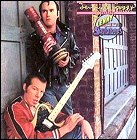 Casablanca Records releases Lenny & Squiggy present Lenny and the Squigtones, an album combining spoken-word comedy and ’50s rock pastiches performed by Michael McKean and David Lander in their characters best known to the general public from recurring appearances on Laverne & Shirley.
Casablanca Records releases Lenny & Squiggy present Lenny and the Squigtones, an album combining spoken-word comedy and ’50s rock pastiches performed by Michael McKean and David Lander in their characters best known to the general public from recurring appearances on Laverne & Shirley.
Buck Rogers soundtrack
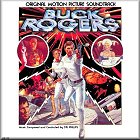 MCA Records releases an LP of Stu Phillips’ soundtrack from Buck Rogers In The 25th Century (timed to coincide with the theatrical release of the pilot movie; the series won’t premiere until later in 1979). After going out of print, the LP becomes a much-sought-after collectors’ item, not receiving a release on CD until the 21st century.
MCA Records releases an LP of Stu Phillips’ soundtrack from Buck Rogers In The 25th Century (timed to coincide with the theatrical release of the pilot movie; the series won’t premiere until later in 1979). After going out of print, the LP becomes a much-sought-after collectors’ item, not receiving a release on CD until the 21st century.
The Compact Disc
 Following five years of research and development, Netherlands-based Philips Electronics demonstrates one of the earliest iterations of the compact audio disc, an optical disc in the now-familiar five-inch size which can be read by a CD player with a laser diode. Philips and Sony, who have been developing the new medium in parallel, will later join forces and create a standard for audio compact discs in 1980, introducing the CD as a consumer product in the early 1980s despite resistance from record companies with a vested interest in vinyl LPs (and only a begrudging acceptance of audio cassettes). In addition to higher audio fidelity and a more durable medium (an optical disc encased in a plastic shell, protecting the physical surface that is so often damaged with vinyl), the CD and its player can also compensate for any damage suffered by the disc through error correction.
Following five years of research and development, Netherlands-based Philips Electronics demonstrates one of the earliest iterations of the compact audio disc, an optical disc in the now-familiar five-inch size which can be read by a CD player with a laser diode. Philips and Sony, who have been developing the new medium in parallel, will later join forces and create a standard for audio compact discs in 1980, introducing the CD as a consumer product in the early 1980s despite resistance from record companies with a vested interest in vinyl LPs (and only a begrudging acceptance of audio cassettes). In addition to higher audio fidelity and a more durable medium (an optical disc encased in a plastic shell, protecting the physical surface that is so often damaged with vinyl), the CD and its player can also compensate for any damage suffered by the disc through error correction.
Split Enz sparks a Frenzy
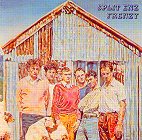 Mushroom Records releases the fourth Split Enz album, Frenzy, recorded after a long period of unemployment for the band, which went to the UK to find fame and became stranded there, too broke to return home. Most members of the group are dissatisfied with the finished album, feeling that it lacks the spark of demos they recorded during their England downtime, but it yields a genuine hit: Tim Finn’s punk-styled anthem “I See Red”.
Mushroom Records releases the fourth Split Enz album, Frenzy, recorded after a long period of unemployment for the band, which went to the UK to find fame and became stranded there, too broke to return home. Most members of the group are dissatisfied with the finished album, feeling that it lacks the spark of demos they recorded during their England downtime, but it yields a genuine hit: Tim Finn’s punk-styled anthem “I See Red”.
Superman: The Movie: The Music
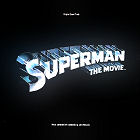 Warner Bros. Records releases a double LP of John Williams’ soundtrack from Superman: The Movie. Now three-and-three for genre blockbusters, Williams’ album again sells well, and will be reissued in several different forms in the years to come.
Warner Bros. Records releases a double LP of John Williams’ soundtrack from Superman: The Movie. Now three-and-three for genre blockbusters, Williams’ album again sells well, and will be reissued in several different forms in the years to come.
Jeff Wayne’s War Of The Worlds
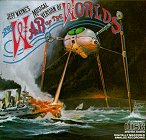 Mars invades Earth again thanks to producer Jeff Wayne, who gathers an unlikely assemblage of prodigious talent around him to create a new musical version of H.G. Wells’ The War Of The Worlds. Featuring Richard Burton, Justin Hayward (of Moody Blues fame), Chris Thompson (Manfred Mann) and others, the double-album becomes an instant classic – a science fiction rock opera.
Mars invades Earth again thanks to producer Jeff Wayne, who gathers an unlikely assemblage of prodigious talent around him to create a new musical version of H.G. Wells’ The War Of The Worlds. Featuring Richard Burton, Justin Hayward (of Moody Blues fame), Chris Thompson (Manfred Mann) and others, the double-album becomes an instant classic – a science fiction rock opera.
More about Jeff Wayne’s Musical Version of The War Of The Worlds in Music Reviews
Alan Parsons Project: Pyramid
 The Alan Parsons Project releases its third album, Pyramid, including the singles “Can’t Take It With You” and “Pyramania”.
The Alan Parsons Project releases its third album, Pyramid, including the singles “Can’t Take It With You” and “Pyramania”.
Soundtrack Encounters of the Third Kind
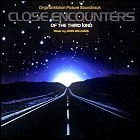 Arista Records releases, just weeks after the movie’s premiere, John Williams’ soundtrack from Close Encounters Of The Third Kind. Sales are brisk, bolstered in no small part by the fact that Williams’ music is on the year’s second major science fiction blockbuster.
Arista Records releases, just weeks after the movie’s premiere, John Williams’ soundtrack from Close Encounters Of The Third Kind. Sales are brisk, bolstered in no small part by the fact that Williams’ music is on the year’s second major science fiction blockbuster.
Electric Light Orchestra: Out Of The Blue
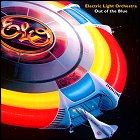 Electric Light Orchestra‘s seventh album, Out Of The Blue, is released, featuring the singles “Sweet Talkin’ Woman”, “Turn To Stone” and “Mr. Blue Sky”. Perhaps reflecting the now-widespread fascination with science fiction, this is the first ELO album to depict the band’s logo as a giant spaceship, a theme which is carried over into the extravagant set for the world tour that takes up ELO’s schedule for the next year.
Electric Light Orchestra‘s seventh album, Out Of The Blue, is released, featuring the singles “Sweet Talkin’ Woman”, “Turn To Stone” and “Mr. Blue Sky”. Perhaps reflecting the now-widespread fascination with science fiction, this is the first ELO album to depict the band’s logo as a giant spaceship, a theme which is carried over into the extravagant set for the world tour that takes up ELO’s schedule for the next year.
Star Wars tops the charts
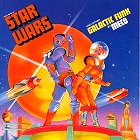 Produced in the wake of Star Wars mania, Meco Menardo’s disco cover of John Williams’ music from Star Wars tops the Billboard Hot 100 chart for two weeks. A shortened, radio-friendly single is the song certified as #1, although the album version (titled Star Wars and Other Galactic Funk) is an extended suite lasting over 15 minutes and covering most of the movie’s major music themes. Meco would continue to ride the Star Wars train, disco-style, for years to come.
Produced in the wake of Star Wars mania, Meco Menardo’s disco cover of John Williams’ music from Star Wars tops the Billboard Hot 100 chart for two weeks. A shortened, radio-friendly single is the song certified as #1, although the album version (titled Star Wars and Other Galactic Funk) is an extended suite lasting over 15 minutes and covering most of the movie’s major music themes. Meco would continue to ride the Star Wars train, disco-style, for years to come.
More about Star Wars soundtracks in theLogBook.com’s Music Reviews
Hear about it on the Sci-Fi 5 podcast
Split Enz experiences Dizrythmia
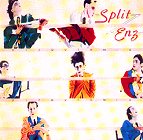 Mushroom Records releases the third Split Enz album, Dizrythmia, the first of the group’s recorded output to feature frontman Tim Finn’s younger brother Neil as the new guitarist. This is also the first album to feature new recruits Nigel Griggs on bass and drummer Mal Green, both of whom will remain through the band at the peak of its success in the early 1980s.
Mushroom Records releases the third Split Enz album, Dizrythmia, the first of the group’s recorded output to feature frontman Tim Finn’s younger brother Neil as the new guitarist. This is also the first album to feature new recruits Nigel Griggs on bass and drummer Mal Green, both of whom will remain through the band at the peak of its success in the early 1980s.
10cc: Deceptive Bends
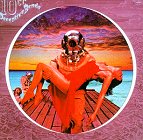 Mercury Records releases 10cc‘s fifth album, Deceptive Bends, the first to be recorded after the departure of founding members Kevin Godley and Lol Creme. The singles “The Things We Do For Love” and “Good Morning Judge” originate from this album.
Mercury Records releases 10cc‘s fifth album, Deceptive Bends, the first to be recorded after the departure of founding members Kevin Godley and Lol Creme. The singles “The Things We Do For Love” and “Good Morning Judge” originate from this album.
The Golden Record
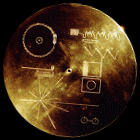 With less than a month to go before the launch of the first of two Voyager unmanned spacecraft, NASA attaches copper phonograph records, encased in lightweight, protective golden casings, to each of the Voyager probes. With participation from Carl Sagan (who led the effort to mount a plaque on the Pioneer probes consisting only of visual information), SETI pioneer Frank Drake, Jon Lomberg and others, the 12″ LP consists of not only sound recordings, but photos and diagrams depicting the diversity and composition of life on Earth. The sounds include various kinds of Earth wildlife, spoken messages from President Jimmy Carter and United Nations Secretary-General Kurt Waldheim, music from Beethoven and Bach to Chuck Berry (the Beatles decline permission to include “Here Comes The Sun”), and Carl Sagan’s young son Nick delcaring “Greetings from the children of planet Earth.” The outer casing includes a playback mechanism and diagrams for how to use it.
With less than a month to go before the launch of the first of two Voyager unmanned spacecraft, NASA attaches copper phonograph records, encased in lightweight, protective golden casings, to each of the Voyager probes. With participation from Carl Sagan (who led the effort to mount a plaque on the Pioneer probes consisting only of visual information), SETI pioneer Frank Drake, Jon Lomberg and others, the 12″ LP consists of not only sound recordings, but photos and diagrams depicting the diversity and composition of life on Earth. The sounds include various kinds of Earth wildlife, spoken messages from President Jimmy Carter and United Nations Secretary-General Kurt Waldheim, music from Beethoven and Bach to Chuck Berry (the Beatles decline permission to include “Here Comes The Sun”), and Carl Sagan’s young son Nick delcaring “Greetings from the children of planet Earth.” The outer casing includes a playback mechanism and diagrams for how to use it.
In the decades to come, fictional aliens visiting or invading Earth because they have viewed the Voyager “Golden Record” becomes a staple of science fiction media.
Alan Parsons Project: I Robot
 The Alan Parsons Project releases its second album, I Robot, including the singles “I Wouldn’t Want To Be Like You”, “Breakdown” and “Don’t Let It Show” (the latter of which is covered latered by Pat Benatar). The album is loosely themed around fear of the future and technology, a far cry from the original plan for a concept album built around Isaac Asimov’s story “I, Robot” (though Asimov allows the album’s title since it lacks the comma). This is the Project’s first album on Arista Records.
The Alan Parsons Project releases its second album, I Robot, including the singles “I Wouldn’t Want To Be Like You”, “Breakdown” and “Don’t Let It Show” (the latter of which is covered latered by Pat Benatar). The album is loosely themed around fear of the future and technology, a far cry from the original plan for a concept album built around Isaac Asimov’s story “I, Robot” (though Asimov allows the album’s title since it lacks the comma). This is the Project’s first album on Arista Records.
Sound Wars
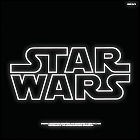 RSO Records releases a double LP of John Williams’ soundtrack from Star Wars, coinciding with the movie’s release. A fold-out poster of publicity artwork of the climactic Death Star dogfight is included. The album becomes a chart-topper by the end of the year, and cover versions by other artists are released even before the year is out. Many listeners become lifelong film score fanatics on the spot.
RSO Records releases a double LP of John Williams’ soundtrack from Star Wars, coinciding with the movie’s release. A fold-out poster of publicity artwork of the climactic Death Star dogfight is included. The album becomes a chart-topper by the end of the year, and cover versions by other artists are released even before the year is out. Many listeners become lifelong film score fanatics on the spot.
Score Wars
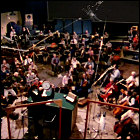 At Anvil Studios in Denham, England, John Williams and the London Symphony Orchestra convene for the first recording session for the Star Wars soundtrack. Over the course of the next 11 days, and with director George Lucas in attendance in the recording booth, all of the music for Lucas’ movie is rehearsed and recorded. Williams and Lucas had been introduced by their mutual friend Steven Spielberg, with whom Williams had worked on 1975’s Jaws (whose score had gone on to win Williams his second Oscar); Lucas’ original plan was to “score” Star Wars entirely with classical pieces. The first scene scored by Williams and the LSO is the rapid-fire chase through the Death Star, culminating in Luke and Princess Leia swinging across a chasm; other pieces recorded on the first day include the death of Obi-Wan Kenobi and the iconic theme music.
At Anvil Studios in Denham, England, John Williams and the London Symphony Orchestra convene for the first recording session for the Star Wars soundtrack. Over the course of the next 11 days, and with director George Lucas in attendance in the recording booth, all of the music for Lucas’ movie is rehearsed and recorded. Williams and Lucas had been introduced by their mutual friend Steven Spielberg, with whom Williams had worked on 1975’s Jaws (whose score had gone on to win Williams his second Oscar); Lucas’ original plan was to “score” Star Wars entirely with classical pieces. The first scene scored by Williams and the LSO is the rapid-fire chase through the Death Star, culminating in Luke and Princess Leia swinging across a chasm; other pieces recorded on the first day include the death of Obi-Wan Kenobi and the iconic theme music.
Peter Gabriel: Peter Gabriel
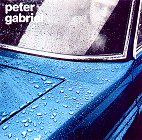 Charisma Records releases Peter Gabriel‘s first self-titled solo album, featuring the single “Solsbury Hill”. This is Gabriel’s first album after departing Genesis.
Charisma Records releases Peter Gabriel‘s first self-titled solo album, featuring the single “Solsbury Hill”. This is Gabriel’s first album after departing Genesis.
Fleetwood Mac: Rumours
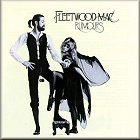 Warner Bros. Records releases Fleetwood Mac‘s 11th album, Rumours, featuring the singles “Don’t Stop”, “Dreams”, “Go Your Own Way”, “You Make Loving Fun”, and “The Chain”. The album is an almost instant chart-topper, capitalizing on the huge following from the band’s 1975 album.
Warner Bros. Records releases Fleetwood Mac‘s 11th album, Rumours, featuring the singles “Don’t Stop”, “Dreams”, “Go Your Own Way”, “You Make Loving Fun”, and “The Chain”. The album is an almost instant chart-topper, capitalizing on the huge following from the band’s 1975 album.
Isao Tomita: The Planets
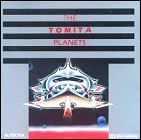 RCA Records releases Isao Tomita‘s interpretation of Holst’s The Planets, a new recording of the famous orchestral suite recorded entirely with synthesizers.
RCA Records releases Isao Tomita‘s interpretation of Holst’s The Planets, a new recording of the famous orchestral suite recorded entirely with synthesizers.
Electric Light Orchestra: New World Record
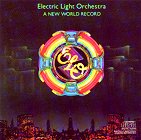 Electric Light Orchestra‘s sixth album, A New World Record, is released, featuring the singles “Livin’ Thing”, “Telephone Line” and “Rockaria!”; the record goes gold and then platinum by the end of the year. This is the group’s first album to sport artwork with the now-familiar ELO logo, created from a mirrored image of the upper part of a Wurlitzer jukebox; following the post-Star Wars science fiction revival, future albums render this logo as a flying saucer.
Electric Light Orchestra‘s sixth album, A New World Record, is released, featuring the singles “Livin’ Thing”, “Telephone Line” and “Rockaria!”; the record goes gold and then platinum by the end of the year. This is the group’s first album to sport artwork with the now-familiar ELO logo, created from a mirrored image of the upper part of a Wurlitzer jukebox; following the post-Star Wars science fiction revival, future albums render this logo as a flying saucer.
Warren Zevon: Warren Zevon
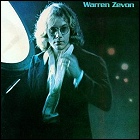 Asylum Records releases Warren Zevon‘s self-titled second album, his first album since 1969.
Asylum Records releases Warren Zevon‘s self-titled second album, his first album since 1969.
The Alan Parsons Project spins Tales
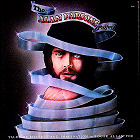 A group of veteran session musicians working under producer Alan Parsons and songwriter Eric Woolfson releases its debut album, The Alan Parsons Project – Tales Of Mystery And Imagination: Edgar Allan Poe. The “group” becomes known, somewhat unintentionally, as the Alan Parsons Project, though that was intended to be part of the album title. Themed around the works of Poe, the album becomes a prog rock cult classic and sells well enough that Parsons and Woolfson begin planning a more futuristic project…
A group of veteran session musicians working under producer Alan Parsons and songwriter Eric Woolfson releases its debut album, The Alan Parsons Project – Tales Of Mystery And Imagination: Edgar Allan Poe. The “group” becomes known, somewhat unintentionally, as the Alan Parsons Project, though that was intended to be part of the album title. Themed around the works of Poe, the album becomes a prog rock cult classic and sells well enough that Parsons and Woolfson begin planning a more futuristic project…
Chicago’s Greatest Hits
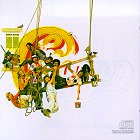 CBS Records releases Chicago’s Greatest Hits (also known as Chicago IX), the first compilation of hit singles from the group, covering their most popular songs from 1969 through 1974.
CBS Records releases Chicago’s Greatest Hits (also known as Chicago IX), the first compilation of hit singles from the group, covering their most popular songs from 1969 through 1974.
Electric Light Orchestra: Face The Music
 Electric Light Orchestra‘s fourth album, Face The Music, is released, featuring the singles “Evil Woman” and “Strange Magic”. The band lineup featured on this album stays largely intact through the early 1980s.
Electric Light Orchestra‘s fourth album, Face The Music, is released, featuring the singles “Evil Woman” and “Strange Magic”. The band lineup featured on this album stays largely intact through the early 1980s.
Roy Wood: Mustard
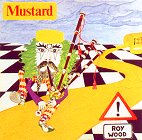 Jet Records releases Roy Wood‘s second solo album, Mustard, which shows off the ELO/Move co-founder’s penchant for ’50s-style rock and his ability to play every instrument in a given song by himself.
Jet Records releases Roy Wood‘s second solo album, Mustard, which shows off the ELO/Move co-founder’s penchant for ’50s-style rock and his ability to play every instrument in a given song by himself.
Split Enz makes Mental Notes
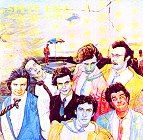 Mushroom Records releases the debut Split Enz album Mental Notes, the product of two months of concentrated recording sessions in Sydney, Australia (and three years of playing live and building a following). The album is a modest success story in Australia and the band’s native New Zealand, and is critically acclaimed for its originality.
Mushroom Records releases the debut Split Enz album Mental Notes, the product of two months of concentrated recording sessions in Sydney, Australia (and three years of playing live and building a following). The album is a modest success story in Australia and the band’s native New Zealand, and is critically acclaimed for its originality.
Genesis: The Lamb Lies Down On Broadway
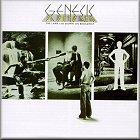 Charisma Records releases Genesis‘ epic-length double album The Lamb Lies Down On Broadway, a mythological concept album which proves to be Peter Gabriel’s last studio album with the band. The album will go on to be widely regarded as one of the creative peaks for the group.
Charisma Records releases Genesis‘ epic-length double album The Lamb Lies Down On Broadway, a mythological concept album which proves to be Peter Gabriel’s last studio album with the band. The album will go on to be widely regarded as one of the creative peaks for the group.
Electric Light Orchestra: Eldorado
 Electric Light Orchestra‘s fourth album, Eldorado, is released, featuring the single “Can’t Get It Out Of My Head”. This is the first ELO album with a full orchestra (as opposed to previous albums’ practice of overdubbing three string players endlessly), and the first to be released in the US before its UK release date.
Electric Light Orchestra‘s fourth album, Eldorado, is released, featuring the single “Can’t Get It Out Of My Head”. This is the first ELO album with a full orchestra (as opposed to previous albums’ practice of overdubbing three string players endlessly), and the first to be released in the US before its UK release date.
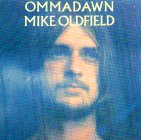 Virgin Records releases
Virgin Records releases